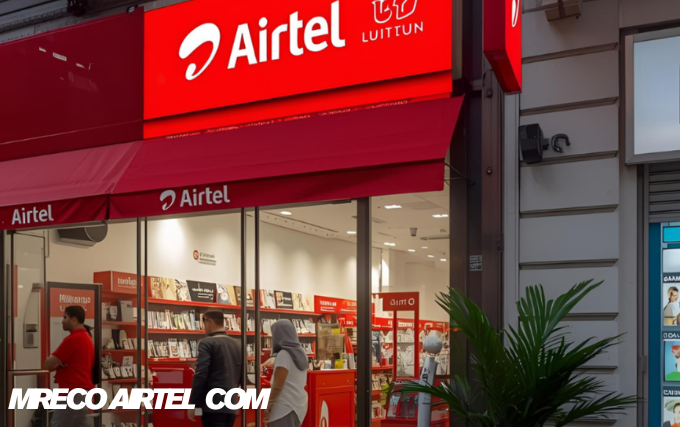Everything You Need to Know About Airtel’s Official Portal

In today’s highly connected world, telecommunications providers increasingly rely on digital platforms to engage with their partners, manage operations, and deliver services efficiently. One such platform is mreco.airtel.com, a portal associated with Airtel that plays a vital role in internal operations, partner management, or retail network support. In this article, we will dive into what mreco.airtel.com is, how it works, whom it serves, how to use it, security concerns, and best practices to maximize its potential.
What Is mreco.airtel.com?
Mreco.airtel.com is a specialized subdomain under Airtel, designed for internal stakeholders, retail partners, or authorized agents to perform back-office tasks, commission management, POS verification, and other business operations. It is not a general consumer-facing site (for bill payments or account management by end users), but rather a portal for the internal or partner ecosystem.
The portal is often used by Airtel retail partners or distributors to manage sales, perform point-of-sale (POS) verification, monitor commissions, submit reports, and receive essential communications from Airtel’s operational units. Videos and community resources indicate that POS address verification links refer to this portal.
Because the site is less public-facing, information on it is relatively limited, and much of its utility is known through partner training materials and tech walkthroughs.
Who Uses mreco.airtel.com?
- Retailers / Franchisees: Authorized individuals or shops that sell Airtel SIMs, recharge services, mobile devices or accessories. They use the portal to get approvals, update location or address, verify POS installation, or submit documentation.
- Distributors: Entities that manage multiple retailer networks downstream; they may use the portal to track sales, push incentives, or reconcile commissions.
- Field Service Engineers / Technicians: For tasks like POS verifications, address checks, or audits, they might access the portal to complete assigned workflows.
- Airtel Internal Teams: Operational staff, audit, and monitoring units may use the portal to oversee partner performance, compliance, serve notices, or send bulk updates.
In short, it is targeted at the B2B channel of Airtel’s ecosystem, not the retail customer.
Key Features and Functionalities
Though Airtel does not publicly publish a full feature list for mreco.airtel.com, combining partner training materials, videos, and experiential hints, the following core functionalities emerge:
POS Verification & Address Validation
A critical use of mreco.airtel.com is verifying the location or address of POS setups. Retailers might need to submit photos, coordinates, or documentation to validate that their shop or stall meets Airtel’s requirements.
Commission and Incentive Tracking
Retailers and distributors can view commission dashboards, check payout status, and reconcile incentive schemes through the portal.
Sales & Transaction Monitoring
Partners may access reports or summaries of transactions, recharge volumes, SIM sales, or other product movements. This helps them track performance relative to targets.
Submission of Documents & Compliance
Retailers might upload KYC or shop address documents, compliance forms, or respond to audits via document uploads within the portal.
Communication & Notices
Airtel can send alerts, circulars, updates, or policy changes directly to retail partners via the portal dashboard or messaging modules.
Workflow Management
Tasks may be assigned (for example, address verification or audit follow-up), and partners can see status updates, pending actions, or escalations.
Because the portal is part of Airtel’s internal architecture, some functions are protected by multi-stage login, role-based access, and workflow gating (i.e., only authorized roles see certain modules).
How to Access and Use mreco.airtel.com
Step 1: Secure Login Credentials
Retailers or partners who are onboarded by Airtel must be provided a login ID and password (or other credentials) from their Airtel distributor or regional office. Without valid credentials, access is restricted.
Step 2: Navigate to the Portal
Use the correct URL mreco.airtel.com in a web browser. Because it is often integrated with Airtel’s internal authentication infrastructure, you may be redirected to a Single Sign-On (SSO) page or identity provider portal.
Step 3: Authenticate via SSO / OTP / MFA
Upon entering credentials, you may be prompted for an OTP (one-time password), multi-factor authentication, or redirect to Airtel’s identity provider. Some public links show Airtel using ADFS-based identity servers for internal logins.
Step 4: Dashboard / Role-Based Access
Once logged in, you will land on a dashboard specific to your user role (retailer, distributor, technician). Tabs or modules may include “POS Verification,” “Commissions,” “Reports,” “Documents,” or “Tasks”.
Step 5: Perform Assigned Tasks
Based on your role and assigned rights, you may: submit a POS address verification request; upload supporting documents; check sales reports; view commission statements; respond to compliance tasks; or see communications from Airtel HQ or region.
Step 6: Logout & Session Security
After finishing, always log out properly to avoid session hijacking, particularly when using shared or public computers.
Because much of this is process-driven, training from Airtel or their field team is often required. Partners should follow internal SOPs to ensure their tasks are processed accurately and on time.
Best Practices and Tips for Partners
- Keep Documentation Ready: For POS verification or audit tasks, maintain clean images, valid identity proofs, shop registration documents, address proofs, and clear photographs of shop frontage.
- Follow Airtel’s Guidelines: Use the format and standards prescribed (such as image dimensions, file types). Incorrect submissions may be rejected.
- Monitor Deadlines: Some tasks may expire or require follow-up within a given window. Watch your dashboard regularly.
- Use a Secure Network: Avoid using public Wi-Fi or insecure networks to log in. Use encrypted, trusted connections.
- Change Passwords Periodically: If allowed, periodically refresh passwords to strengthen security.
- Report Access Issues Promptly: If login fails, contact your regional Airtel support or distributor rather than using random workarounds.
- Understand Role Boundaries: Not all features will be visible to all users—some modules are restricted by role (retailer vs. distributor).
- Train Staff: If your shop has multiple people handling tasks (POS, sales, compliance), ensure each is aware of portal processes and quality expectations.
- Maintain Consistent Records: Align your internal record-keeping (sales, recharges, shop maintenance) with what you submit in the portal to avoid discrepancies.
Security and Legitimacy Considerations
Because mreco.airtel.com is a less publicly visible portal, users must exercise caution and verify authenticity before entering credentials.
SSL / Certificate & Safety
ScamAdviser, a domain safety checker, gives mreco.airtel.com a reasonably high trust score, noting that it has a valid SSL certificate. ScamAdviser While that suggests baseline security, SSL alone is not definitive proof of legitimacy.
Hosted Subdomain
The portal is part of Airtel’s domain space (under airtel.com), which is generally a good sign that it is an official subdomain rather than a standalone or rogue site.
Low Public Visibility
Because the site is intended for internal or partner use, it is not widely advertised. Some partners report it in training videos and POS verification instructions.
Caution with Phishing
Always check the URL carefully. Avoid phishing or spoofed sites that mimic the portal. Do not click on unsolicited links claiming to be part of Airtel portal operations without verifying with your regional Airtel support.
Updates & Maintenance
As with any corporate portal, downtime, server maintenance, or updates might occur. Save drafts or offline work, and don’t panic if occasional maintenance windows temporarily block access.
Common Issues and Troubleshooting
| Issue | Possible Cause | Suggested Remedy |
| Login fails or credential rejected | Wrong credentials, account not approved yet, or role assignment pending | Confirm login details with your Airtel / distributor admin; check if your account is active |
| OTP or MFA doesn’t arrive | Network issues, SMS delivery delays, blocked messages | Request resend, check your phone settings, or contact support |
| Document rejection in POS verification | Photo quality low, incorrect format, insufficient proof | Retake images per guideline, upload required file types |
| Modules not visible | You don’t have that role or permission assigned | Contact distribution / regional manager to assign permissions |
| Dashboard not reflecting new tasks | Cache, session lag, or delayed workflow propagation | Logout / login again, clear browser cache, wait for workflow sync |
| Slow loading or server errors | Network issue, maintenance, heavy load | Try during off-peak hours; contact tech support if persistent |
By understanding the root causes of common problems, partners can work more smoothly with Airtel operations teams and reduce delays.
Benefits for Retail Partners
- Operational Efficiency: Rather than relying on offline paperwork or walk-in processing, partners can complete many tasks online via the portal.
- Transparency: Partners can track their commissions, status of verification requests, or task completions visible at all times.
- Faster Turnaround: Because tasks (such as POS approvals) can be processed digitally, delays are reduced compared to manual channels.
- Structured Workflow: By following defined steps and guidelines, Airtel and partners maintain consistency, quality, and accountability.
- Better Communication: Airtel can push policy changes or region-specific instructions directly via portal notifications.
Limitations and What to Keep in Mind
- Restricted to Authorized Users: If you are not an Airtel partner or your account is not onboarded, you will not be able to access anything meaningful.
- Role Constraints: Certain features may be deliberately hidden for lower-level users; you may need upward escalation to access advanced modules.
- Reliance on Backend Systems: Many modules might depend on integration with Airtel’s internal databases, so issues on those systems can cascade to portal performance.
- Documentation Dependencies: Many tasks require supporting documents, photos, or proofs—without which tasks are rejected or delayed.
- Limited Public Documentation: Because it is not consumer-facing, official user manuals or guides are scarce, meaning partner training is critical.
Conclusion
Mreco.airtel.com is a crucial operational portal in Airtel’s partner ecosystem, enabling retailers, technicians, and distribution partners to manage verification, commissions, documentation, sales reporting, and internal workflows. It is not intended for general customers, but rather for authorized stakeholders in Airtel’s B2B chain.
By securing proper access, following guidelines, maintaining quality in submissions, and working closely with Airtel operations teams, partners can leverage this portal for smoother operations and greater transparency. At the same time, users should remain vigilant about security, certificate authenticity, and phishing risks.
If you are an Airtel partner or considering being one, it’s essential to familiarize yourself with mreco.airtel.com as it likely will be part of your day-to-day tasks. If you want a step-by-step tutorial with screenshots or a guide specific to your country or region, I can prepare that as well. Would you like me to produce a walkthrough for your area?
